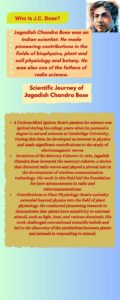Describe Jagadish Chandra Bose’s contributions to contemporary science. (Answer in 150 words)
Resources & Suggestions
Mains Answer Writing Latest Articles
Daily Answer Writing Practice Questions (24 February 2025)
The rise of the work-from-home culture has brought about several ethical issues in private organizations. In this context, do you believe it is ethical for an employee to engage in moonlighting? Discuss. (Answer in 150 words) घर से काम करने ...
Indo-US Relation: Areas of Cooperation & Conflicts
Key Areas: Defense, technology, trade, energy, and regional cooperation. Key Areas of Cooperation 1. Defense and Security Transition from buyer-seller to co-production and technology sharing. India as a Major Defense Partner (MDP) and inclusion in STA-1. Access to advanced technologies, ...
भारत-अमेरिका संबंध: सहयोग और संघर्ष के क्षेत्र
मुख्य विषय: भारत-अमेरिका संबंधों की मजबूती, विशेषकर रक्षा, प्रौद्योगिकी और क्षेत्रीय सहयोग में प्रगति। सहयोग के प्रमुख क्षेत्र 1. रक्षा एवं सुरक्षा सहयोग भारत और अमेरिका के बीच रक्षा संबंधों का विस्तार। प्रमुख रक्षा साझेदार (MDP) का दर्जा और STA-1 ...

Sir Jagadish Chandra Bose (1858-1937) is acknowledged as the greatest interdisciplinary scientist in India. He was the first Indian to be appointed as a Professor of Physics at the Presidency College, Calcutta. He received a Knighthood from the British Government in 1917 and later he was elected as a fellow of the Royal Society (FRS) of London in 1920. Study of Radio Waves and Wireless Technology
Studies on the physiology and biophysics of plants
Apart from these, inspired by nationalist ideals, he founded the Bose Institute in 1917, which was Asia’s first modern research center, which focussed on interdisciplinary research. He was also the president of the 14th session of the Indian Science Congress in 1927. Currently, the Bose Institute in Kolkata is keeping up its motto and is training several young Indian scientists and offering state-of-the-art facilities in physics and biology.
Jagadish Chandra Bose (30 November 1858 – 23 November 1937) was a polymath with interests in biology, physics, botany and writing science fiction and made significant contributions to botany. He was not awarded the Nobel Prize. Despite his contributions and break throughs on wireless connectivity, the Nobel Prize in physics for wireless was awarded to Guglielmo Marconi in 1909.
Famous experiment —
Bose made pioneering discoveries in plant physiology. He used his own invention, the crescograph, to measure plant response to various stimuli.
Jagadish Chandra Bose discovered that plants can move in response to stimuli, such as exposure to light, fertilizers, or poisons. He invented a device called a crescograph that could measure very small motions in plants and used it to measure plant motion that was caused by exposure to various stimuli.
The experiment was conducted by Bose at the Royal Society of London in 1901 demonstrated that just like humans, plants too have feelings.
Bose was an Indian polymath, made significant contributions to various fields, particularly in plant physiology and physics. Here are some of his contributions in the field of modern science:
– Bose was a pioneer in the field of radio and microwave optics. He conducted extensive research on the propagation of electromagnetic waves and was one of the first to demonstrate the generation and reception of radio waves.
– In 1895, Bose conducted a public demonstration of wireless communication using radio waves, preceding Guglielmo Marconi’s more famous experiments by a few years. However, Bose did not commercialize his inventions, focusing instead on scientific exploration.
– Bose is renowned for his groundbreaking work in plant physiology. He developed highly sensitive instruments, such as the crescograph, to measure plant responses to various stimuli.
– Through his experiments, Bose demonstrated that plants have the ability to feel pain and respond to various environmental factors, challenging the then-prevailing notion that plants were insentient.
– Bose’s work on the response of metals to electromagnetic waves laid the foundation for the development of semiconductor technology. His research demonstrated the use of semiconductors to detect radio waves, which was an early step toward the development of modern electronics.
4. Biophysics
– Bose’s interdisciplinary approach led to the merging of biology and physics, creating the field of biophysics. His studies on the electrical nature of cell membranes and the transmission of electrical impulses in plants were pioneering.
– Bose invented several instruments to aid in his research, including the crescograph and the Boseian crescograph, which amplified the minute movements of plants and enabled detailed study of their growth patterns and responses.
Bose’s work has had a lasting impact on both the physical and biological sciences, influencing future research and technological advancements. His interdisciplinary approach and innovative thinking continue to inspire scientists today.
Hello, Kindly find the link attached here for the detailed answer of the question:
https://www.canva.com/design/DAGKvW-SBdM/x_7gegrrT9SqjLMa6dLeaQ/edit?utm_content=DAGKvW-SBdM&utm_campaign=designshare&utm_medium=link2&utm_source=sharebuttonWho Is J.C. Bose

 Who Is J.C. Bose
Who Is J.C. Bose
Jagadish Chandra Bose (1858- ) was a physicist, botanist, and biologist who made significant contributions to science in the fields of radio, microwaves, and botany
He’s considered a pioneer in radio science and wireless telecommunication, which laid the groundwork for the invention of radio, TV, wifi, and cell phones.
Radio and microwaves
Bose invented the crystal detector, an early radio receiver, and a new coherer that enabled longer distance wireless transmission of radio waves.
Botany
Bose studied plant responses to stimuli and invented the crescograph, a device that measured minute plant movements in response to light, poisons, and other stimuli.
Other contributions
Bose speculated on the existence of electromagnetic radiation from the sun, which was later discovered in 1942.
Jagadish Chandra Bose made significant contributions across various disciplines in contemporary science. He pioneered the investigation of radio waves and wireless communication, conducting experiments that laid the foundation for later developments in this field. His research predated Marconi’s work and established fundamental principles in electromagnetic waves.
In plant physiology, Bose’s experiments with plants demonstrated their sensitivity to environmental stimuli like light, temperature, and electrical signals. He invented the crescograph to measure plant responses accurately, contributing profoundly to our understanding of how plants grow and react to their surroundings.
Additionally, Bose’s studies in semiconductor physics were groundbreaking. He explored the behavior of metals and semiconductors under different conditions, anticipating modern developments in solid-state physics and semiconductor technology.
Bose’s legacy extends beyond his scientific discoveries; he was a staunch advocate for scientific education and public engagement. His efforts in promoting scientific temper and establishing scientific societies have had a lasting impact on science education in India and globally. Bose’s work continues to inspire and influence advancements in physics, biology, and technology today.
JAGADISH CHANDRA BOSE’S CONTRIBUTIONS TO CONTEMPORARY SCIENCE
Jagadish Chandra Bose, a pioneering Indian scientist, made profound contributions to contemporary science, bridging the gap between physics, biology, and botany. His groundbreaking research on microwaves laid the foundation for wireless communication technologies like radar and satellite communication. He challenged the separation between living and non-living matter by demonstrating the similarities in their responses to stimuli, paving the way for understanding the electrical nature of life processes. His invention, the Crescograph, allowed him to measure plant growth in real-time, pioneering research into plant sensitivity.
Bose’s work was also foundational for interdisciplinary research, advocating for scientific inquiry in India and inspiring generations of scientists. His legacy continues to inspire researchers today, emphasizing the interconnectedness of scientific fields and the power of innovation in tackling complex global challenges.
Jagadish Chandra Bose, a pioneering Indian scientist, made significant contributions across multiple scientific fields, including physics, botany, and plant physiology. His groundbreaking research in microwaves and wireless communication laid the foundation for modern communication technologies. Bose’s invention of the crescograph revolutionized plant physiology by demonstrating plant responses to stimuli, challenging existing notions about plant life. His interdisciplinary approach bridged biology and physics, paving the way for biophysics and advancing semiconductor research. Bose’s legacy continues to inspire scientific innovation and interdisciplinary research.
Microwaves and Wireless Communication: Bose was a trailblazer in radio and microwave optics, conducting pioneering research on electromagnetic wave propagation. In 1895, he publicly demonstrated wireless communication using radio waves, preceding Guglielmo Marconi. Bose developed a microwave generator producing millimeter-length waves, which are foundational for today’s 5G technology.
Plant Physiology: Bose’s groundbreaking work in plant physiology involved developing the crescograph, a device that measured plant responses to various stimuli. His experiments demonstrated that plants could feel pain and respond to environmental factors, challenging the notion that plants were insentient.
Interdisciplinary Research: Bose’s interdisciplinary approach merged biology and physics, contributing to biophysics. He studied the electrical nature of cell membranes and the transmission of electrical impulses in plants, pioneering research that bridged the gap between living and non-living matter.
Semiconductor Research: Bose’s work on the response of metals to electromagnetic waves laid the groundwork for semiconductor technology. His research demonstrated using semiconductors to detect radio waves, an early step toward modern electronics.
Scientific Instruments: Bose invented several instruments, including the Boseian crescograph and the Photosynthesis Recorder, enabling detailed study of plant growth patterns and photosynthetic activity.
Legacy and Influence: Bose inspired generations of scientists and founded the Bose Institute in 1917, Asia’s first modern research center, promoting interdisciplinary research. His legacy continues to inspire innovation and scientific inquiry globally.
In summary, Bose’s innovative contributions have had a lasting impact on various scientific fields, emphasizing the interconnectedness of disciplines and the power of innovation.
Jagadish Chandra Bose, a pioneering Indian scientist, made significant contributions across multiple scientific fields, including physics, botany, and plant physiology. His groundbreaking research in microwaves and wireless communication laid the foundation for modern communication technologies. Bose’s invention of the crescograph revolutionized plant physiology by demonstrating plant responses to stimuli, challenging existing notions about plant life. His interdisciplinary approach bridged biology and physics, paving the way for biophysics and advancing semiconductor research. Bose’s legacy continues to inspire scientific innovation and interdisciplinary research.
Microwaves and Wireless Communication: Bose was a trailblazer in radio and microwave optics, conducting pioneering research on electromagnetic wave propagation. In 1895, he publicly demonstrated wireless communication using radio waves, preceding Guglielmo Marconi. Bose developed a microwave generator producing millimeter-length waves, which are foundational for today’s 5G technology.
Plant Physiology: Bose’s groundbreaking work in plant physiology involved developing the crescograph, a device that measured plant responses to various stimuli. His experiments demonstrated that plants could feel pain and respond to environmental factors, challenging the notion that plants were insentient.
Interdisciplinary Research: Bose’s interdisciplinary approach merged biology and physics, contributing to biophysics. He studied the electrical nature of cell membranes and the transmission of electrical impulses in plants, pioneering research that bridged the gap between living and non-living matter.
Semiconductor Research: Bose’s work on the response of metals to electromagnetic waves laid the groundwork for semiconductor technology. His research demonstrated using semiconductors to detect radio waves, an early step toward modern electronics.
Scientific Instruments: Bose invented several instruments, including the Boseian crescograph and the Photosynthesis Recorder, enabling detailed study of plant growth patterns and photosynthetic activity.
Legacy and Influence: Bose inspired generations of scientists and founded the Bose Institute in 1917, Asia’s first modern research center, promoting interdisciplinary research. His legacy continues to inspire innovation and scientific inquiry globally.
In summary, Bose’s innovative contributions have had a lasting impact on various scientific fields, emphasizing the interconnectedness of disciplines and the power of innovation.
Sir Jagadish Chandra Bose (1858-1937) was a distinguished Indian polymath and educator. Born in Mymensingh, Bengal to Debendranath and Bamasundari Bose.He studied at Cambridge and London and received knighthood from british crown in 1917.
Contributions of Jagdish Chandra Bose to Modern Science –
Jagadish Chandra Bose was a true pioneer, making lasting impacts on science and education. His groundbreaking work inspires generations, securing his place as India’s legendary scientist and visionary.